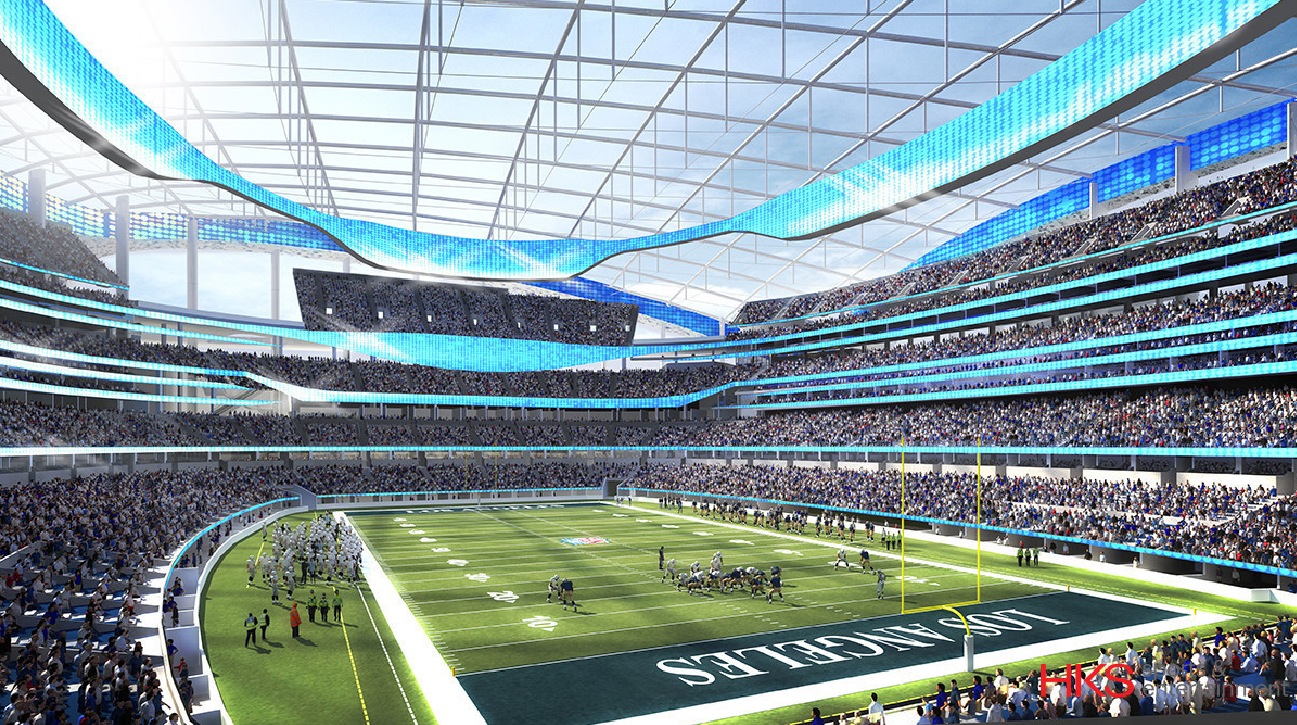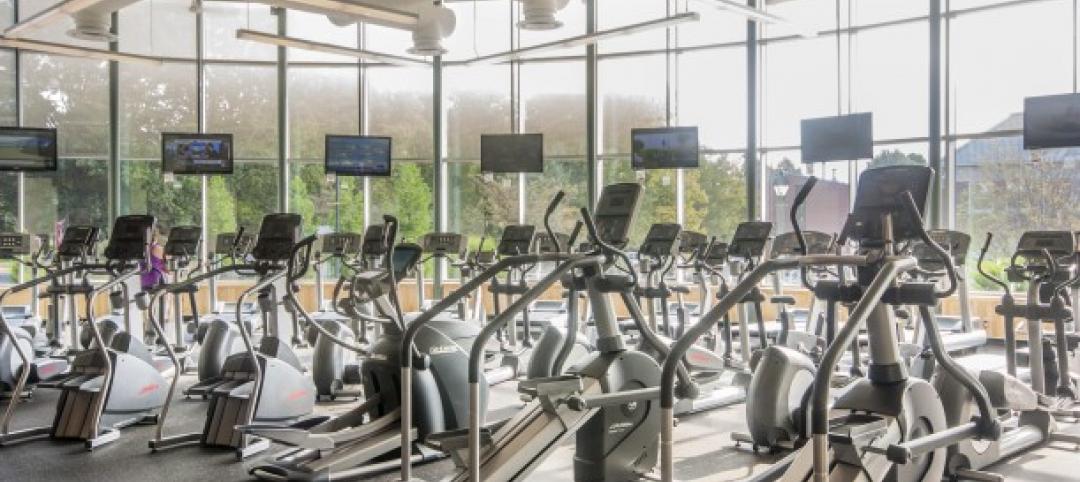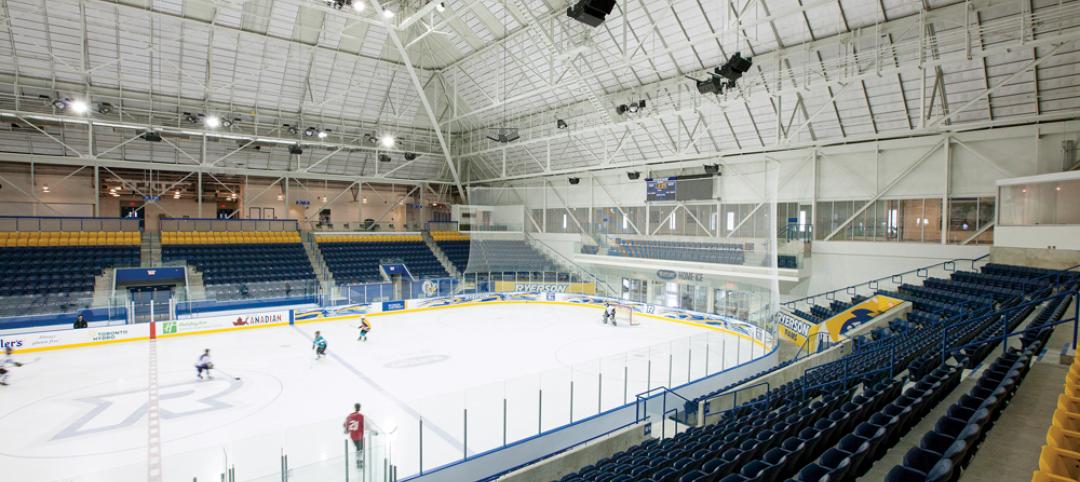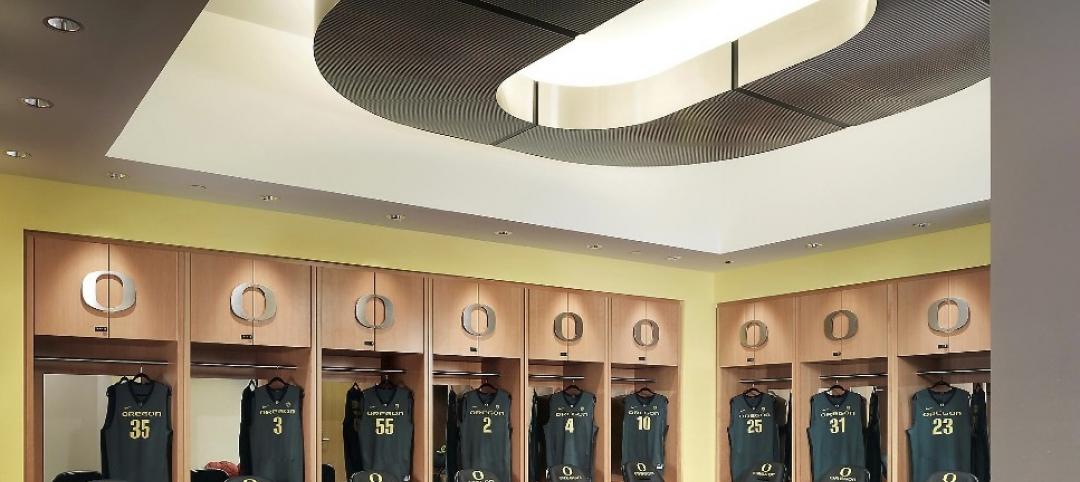After years of rumors and speculation, and with plenty of moving parts that still need to be sorted out, at least one thing is official: the St. Louis Rams are Los Angeles-bound.
The NFL owners voted in favor of the Rams’ plan of moving back to the city they called home from 1946 to 1994.
A new stadium will be built in Inglewood, Calif., on the site of the old Hollywood Park racetrack, roughly 10 miles from downtown Los Angeles. It is expected to be the league’s largest stadium in terms of area (at 8.5 million sf), and will cost between $1.8 billion and $3 billion.
The stadium will be set 100 feet into the ground with a 175-foot above ground profile. The roof will have open air on its sides with metal borders at the top, and the section over the playing field will be made of the transparent ETFE material, which is translucent but immensely strong. The stadium, which will have 70,000 seats and could expand to 100,000 with standing room only capacity, will be part of a 298-acre entertainment, retail, and housing complex.
“It's going to be so much more than going to a football game,” said Mark Williams of HKS, the firm designing the stadium, according to the Los Angeles Times. “You're going to be absorbed into the site, absorbed into the stadium, and get a very wide bandwidth of experience. It's the kind of memory people are going to cherish for a lifetime.”
The NFL is in favor of two teams moving to LA and sharing a stadium. The San Diego Chargers have the option of leaving their digs, the old Qualcomm Stadium, and joining the Rams in becoming co-tenants at the new LA stadium. They have a little more than one year to make a decision. If they decline, then the Oakland Raiders could choose to move from their home, the O.co Coliseum, and play in the new stadium with the Rams.
Meanwhile, both the Chargers and Raiders are working to stay in their current cities (at least that's what both teams’ owners are saying). If they stay, the NFL will give them each $100 million toward a new stadium.
The original plan for the Raiders and Chargers was for the teams to share a stadium, designed by Manica Architecture, in Carson, Calif. That was voted down by the owners in part because of logistics (the league would’ve had to realign divisions), and in part due to location. The $1.7 billion stadium in Carson would’ve been built on top of an old landfill.
 The proposed Carson Stadium was voted down by NFL owners. Rendering: Manica Architecture
The proposed Carson Stadium was voted down by NFL owners. Rendering: Manica Architecture
The next step for the Rams will be to determine where they’ll play next. The team’s temporary home is expected to be the LA Coliseum, a 92-year-old bowl stadium that seats more than 93,000 people. The University of Southern California’s football team currently plays there on Saturdays. Other options for the Rams include the Rose Bowl in Pasadena and Angel Stadium of Anaheim.
Los Angeles has been without football since the 1994 season, when both the Rams and Raiders moved. For the 1995 season, the Rams played at St. Louis’s Busch Stadium before moving into the now-named Edward Jones Dome later in the season. The Rams stayed at the dome through the 2015 season.
The Rams turned down a recent plan to stay in St. Louis, which included a $1 billion HOK-designed stadium on the Mississippi River.
Though financing was an issue for the proposed St. Louis stadium, it’s unclear how serious the team considered the plan. Rams’ owner Stan Kroenke bought the land in Inglewood back in early 2014, which had fueled relocation rumors since.
 The proposed riverfront stadium in St. Louis. Rendering: HOK
The proposed riverfront stadium in St. Louis. Rendering: HOK
Related Stories
| Nov 19, 2013
Top 10 green building products for 2014
Assa Abloy's power-over-ethernet access-control locks and Schüco's retrofit façade system are among the products to make BuildingGreen Inc.'s annual Top-10 Green Building Products list.
| Nov 13, 2013
Installed capacity of geothermal heat pumps to grow by 150% by 2020, says study
The worldwide installed capacity of GHP systems will reach 127.4 gigawatts-thermal over the next seven years, growth of nearly 150%, according to a recent report from Navigant Research.
| Nov 7, 2013
Fitness center design: What do higher-ed students want?
Campus fitness centers are taking their place alongside student centers, science centers, and libraries as hallmark components of a student-life experience. Here are some tips for identifying the ideal design features for your next higher-ed fitness center project.
| Oct 30, 2013
11 hot BIM/VDC topics for 2013
If you like to geek out on building information modeling and virtual design and construction, you should enjoy this overview of the top BIM/VDC topics.
| Oct 28, 2013
Urban growth doesn’t have to destroy nature—it can work with it
Our collective desire to live in cities has never been stronger. According to the World Health Organization, 60% of the world’s population will live in a city by 2030. As urban populations swell, what people demand from their cities is evolving.
| Oct 18, 2013
Researchers discover tension-fusing properties of metal
When a group of MIT researchers recently discovered that stress can cause metal alloy to fuse rather than break apart, they assumed it must be a mistake. It wasn't. The surprising finding could lead to self-healing materials that repair early damage before it has a chance to spread.
| Oct 8, 2013
Toronto Maple Leafs arena converted to university recreation facility
Using steel reinforcement and massive box trusses, a Building Team methodically inserts four new floors in the landmark arena while preserving and restoring its historic exterior.
| Oct 1, 2013
13 structural steel buildings that dazzle
The Barclays Center arena in Brooklyn and the NASCAR Hall of Fame in Charlotte, N.C., are among projects named 2013 IDEAS2 winners by the American Institute of Steel Construction.
| Sep 26, 2013
6 ways to maximize home-field advantage in sports venue design
Home-field advantage can play a significant role in game outcomes. Here are ways AEC firms can help create the conditions that draw big crowds, energize the home team to perform better, and disrupt visiting players.
| Sep 24, 2013
8 grand green roofs (and walls)
A dramatic interior green wall at Drexel University and a massive, 4.4-acre vegetated roof at the Kauffman Performing Arts Center in Kansas City are among the projects honored in the 2013 Green Roof and Wall Awards of Excellence.

















